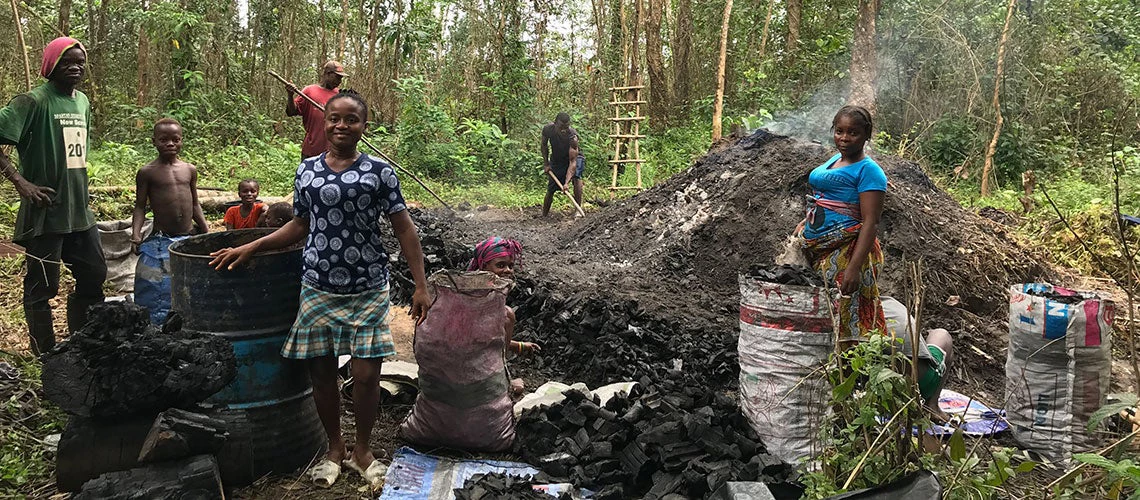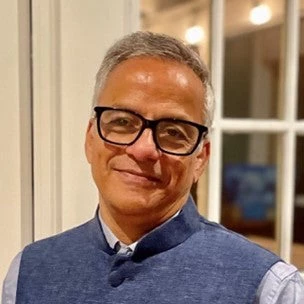 Women working in the forest in Liberia. Here, forestry is the fourth largest contributor to the economy after services, agriculture, and fisheries, mining, and panning.
Women working in the forest in Liberia. Here, forestry is the fourth largest contributor to the economy after services, agriculture, and fisheries, mining, and panning.
In Liberia, half of the population lives within 2.5 kilometers of a forest. Each day, these households spend over three hours collecting forest products for subsistence and for sale, earning 35% of their income. In case of crisis such as droughts, fires, floods or pandemics, forests provide a safety net, offering resources to recover from the shocks. Informal and largely unmeasured, forest activities provide an important source of jobs, income and food security. Despite the crucial role forests play in sustaining livelihoods, 12.2% of Liberia’s forest cover was lost from 1990 to 2010.
Understanding household-forest interactions is crucial if we aim to optimize communities’ benefits from forests while preserving the resources. Without data, policymakers have been unable to grasp the economic and social connections between households and forests and their implications for livelihoods and sustainability. The recent Liberia National Household Forest Survey (NHFS) prepared by the World Bank closes this knowledge gap and offers new light on the contribution of forests to household’s incomes, subsistence, and resilience. The findings will inform the design of interventions intended to reduce the poverty of forest-dependent communities.
The 2018-2019 National Forest Inventory estimates that Liberia’s forests make up more than two-thirds of the country’s land area and cover 6.69 million hectares, equivalent to twice the size of Belgium . Forests are home to a rich biodiversity: 881 known fauna species, of which 0.8% are endemic and 4.2% threatened; and at least 2,200 flora species of vascular plants, of which 4.7% are endemic.
Forestry is the fourth largest contributor to the economy after services, agriculture, and fisheries, mining, and panning. The formal forest sector contributes 10% to GDP and employs 39,880 full-time equivalent workers, of whom 35% are women (2020 Liberia Forest Resources Assessment). The informal sector also brings countless benefits to communities. Chainsaw milling provides up to 24,000 regular jobs and contributes each year, up to $41 million, about 3 to 4% of GDP. The charcoal industry employs up to 28,000 people on a regular basis. Non-Timber Forest Products such as fruits, honey, meat, nuts, and plants are vital to the livelihoods of most of the rural population.
Deforestation during the war when forest revenues were used to finance weapons, a growing population, and increasing human pressures have led to the loss of Liberia’s forests. Moreover, the economic impacts of the COVID-19 pandemic are likely to exert more pressure, given people’s easy access to neighboring forests and their shrinking sources of alternative livelihoods. This can create a vicious cycle of over-extraction, forest degradation, and ultimately a decline in the resources needed to meet household needs.
In 2018, a joint World Bank-Government of Liberia team conducted this first forest survey focusing on households living in communities within 2.5 kilometers of forest , making up nearly half of Liberia’s population. The findings are highly relevant to Liberia's pro-poor agenda for prosperity and development.
The survey reveals interesting facts. Households living in the vicinity of forests earn one third or what others are earning: they have an annual income of US$783, equivalent to $0.54 per person per day, which is far below the average of US$2,440.
About 70% of the households collect forest products for self-consumption and/or for sale. Every day, they spend over three hours collecting respectively fuelwood, bushmeat, and shelter. Despite the time spent, only 24 percent of the households report processing the products for value addition. Forty-three percent of households reported using forest products to recover from shocks and two-thirds that experienced food insecurity relied on forest products to meet their needs.
In terms of governance, the survey reveals that forest management programs offered by the government and development partners have low community participation. Rules on who can collect forest products and how much, are mostly set by male heads of communities with strong influence. While more men than women participate in community level meetings, women’s opinions are recognized and incorporated in decision-making.
In light of these results, it will be important for Liberia to use its forests as a renewable and sustainable income-generating asset. Pressures on forests can be lessened without compromising the livelihoods of proximate communities. This can be done by creating alternative and complementary means of earning a living. Communities can also be empowered to help manage the forests in a sustainable, transparent, and inclusive manner.
Authorities must play a key role in widening and deepening the coverage of sustainable forest management programs, in strengthening markets for forest products, and in increasing the number of women entrepreneurs, to name a few. Strengthening the governance of the sector at local level is also crucial. This can be done by informing community dialogue and actions, setting rules on the collection of forest products, and finally monitoring and measuring the outcomes.
Without action, forests will be poverty-traps for households whose lives, food and income depend on them . Through the $37.5 million Liberia Forest Sector Project, the World Bank is supporting the Government of Liberia to sustainably manage its precious natural resources and create opportunities for forest-dependent communities.
The Liberia National Household Forest Surveywas funded by the World Bank’s Forest Carbon Partnership Facility, the Program for Forests (PROFOR), and the Norwegian Ministry of Climate and Environment, under the Liberia Forest Landscape Trust Fund.



Join the Conversation